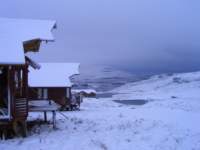SHENZHEN, CHINA - The snowboarder limbers up, swinging her arms and giving a few swift hops on the board. She flips the tail of her knit ski cap out of her eyes and then plunges down the hill. She's at the bottom in about 40 seconds.
The Swiss Alps this is not.
It's southern China, a region known more for its smog than snow. In fact, the blue sky above this modest slope is fake - it's painted onto the ceiling of this chilly chamber where the snow is man-made and music is piped in over loudspeakers.
Welcome to indoor skiing. (Yes, you read that correctly.)
"It's not the real thing, of course," said American Scott Addonizio before hitting the slopes on a recent Saturday at Shenzhen's Alps Indoor Ski Dome. "But it's something to do, and there are some pretty good boarders that come out."
As China's economy continues to skyrocket, its demand for luxury entertainment is rising. But in the case of downhill skiing, China's entrepreneurs aren't only imitating their Western counterparts, but going one step further. From Shenzhen to Beijing, indoor ski centers are pumping out snow for locals interested in learning how to ski and homesick expatriates in need of a weekend break.
Meanwhile, those in the US who dream of skiing indoors will have to wait a little longer. In 2007, New Jersey will be opening the Snow Dome, the country's first year-round indoor Alpine "ski resort," complete with snow and chairlifts. Xanadu, located in the Meadowlands, will be a sprawling sports, office, and entertainment complex that will include a 140-foot-high dome covering 250,000 square feet, according to company plans.
Indoor skiing originated in Australia in the late 1980s and quickly migrated throughout Asia and Europe. The world's largest ski dome - the size of about three football fields - opened this past December in oil-wealthy Dubai.
Here in Shenzhen, an hour train ride from downtown Hong Kong, you can hit the slopes at Window of the World's Alps Indoor Ski Dome. One hour on the 262-foot-long slope includes skis, boots, jacket, and snow pants for $10. Lessons are available from patient locals, as are scream-inducing sled runs on inner tubes.
On weekdays the "ski resort" usually isn't crowded, but on weekends groups of Hong Kongers are there practicing their turns.
"I've been coming since they opened," says one Chinese resident who asked not to be named for personal reasons. "Someday I'll do the real thing, but I don't have the money right now."
In Shanghai, the Yinqixing Indoor Skiing Site offers an all-day pass for $27. At a length of 1,246 ft. and a width of 262 ft., it's much larger than the ski run in Shenzhen. The slope also includes a practice flat for beginners to test their skills. A trip to the sauna afterward costs 75 cents.
Not to be outdone, Beijing recently opened its first indoor ski center to add to the many outdoor ski resorts around the city. Qiaobo Ski and Snow World is named after Ye Qiaobo, who won China's first silver medal in the Winter Olympics in 1992.
A day at this megasite is priced at $17, but the cost to the city could be much higher. Just after the resort opened, the China Daily, a state-run newspaper, reported that converting water to snow was draining the limited water supply for farmers on the city's outskirts. Critics suggest the story is a governmental campaign against the ski center - in effect, a shot at the bourgeois notion of donning jacket and gloves during Beijing's summer.
from the January 06, 2006 edition -
By Alex Ortolani | Contributor to The Christian Science Monitor









